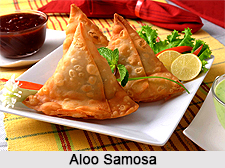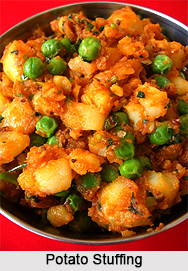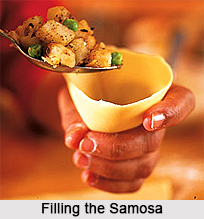 Aloo Samosa is one of the popular snacks in India which is available with various savoury filings such as spiced potatoes, onions, peas, lentils, etc. The typical shape of a samosa is triangular but it can be availed in varied sizes. It is normally stuffed with small pieces of potato along with other ingredients. It is wrapped in thin dough and the coating is done with white flour. Samosa is served hot accompanied with tomato sauce or different type of Indian chutneys such as mint, coriander or tamarind. It is also used in various chaats to enhance their taste. Samosa can also be prepared in sweet form if required.
Aloo Samosa is one of the popular snacks in India which is available with various savoury filings such as spiced potatoes, onions, peas, lentils, etc. The typical shape of a samosa is triangular but it can be availed in varied sizes. It is normally stuffed with small pieces of potato along with other ingredients. It is wrapped in thin dough and the coating is done with white flour. Samosa is served hot accompanied with tomato sauce or different type of Indian chutneys such as mint, coriander or tamarind. It is also used in various chaats to enhance their taste. Samosa can also be prepared in sweet form if required.
Origin of Aloo Samosa
Aloo Samosa has originated in Central Asia where it was consumed as early as the 10th century. In Central Asia, it was called as "Samsa". Muslim merchants later brought Samosa in Indian subcontinent along the ancient trade routes in the 13th or 14th century. It did not take much time to receive popularity in India due to its quick preparation time and convenient shape and size.
Variations of Samosa
Samosas are generally bigger in size in Delhi, Punjab, Himachal Pradesh, Madhya Pradesh, Uttar Pradesh, Uttarakhand and other Northern States of India. Here the samosas are filled up with potatoes, peas, crushed green chillies and sometimes dry fruits. In West Bengal, it is smaller in size and is popularly known as "Shingara".

In South India, the filling of samosa is influenced by the local food habits. The filling is done with mashed potatoes with spices, fried onions, peas, carrots, cabbage, curry leaves, green chillies, etc. It is mostly eaten without chutney. In Hyderabad, it comes with a thicker pastry crust and mince-meat filling referred to as "Lukhmi".
Ingredients for Aloo Samosa:
•2 cups Flour
•1/2 tsp Salt
•4 tbsp Oil
•4 tbsp Water
Ingredients for Stuffing:
•4-5 medium Potatoes boiled
•4 tbsp Oil
•1 medium Onion, peeled and finely chopped
•1 cup shelled Peas
•1 tbsp grated Ginger
•1 Green Chilli, finely chopped
•3 tbsp finely chopped Coriander
•3 tbsp Water
•1 and 1/2 tsp Salt
•1 tsp ground Coriander seeds
•1 tsp Garam Masala
•1 tsp ground roasted Cumin seeds
•2 tbsp Lemon juice
•Oil for deep frying

Method:
•Sift the flour and salt into a bowl.
•Add the 4 tbsp oil and rub it with fingers until the mixture resembles coarse breadcrumbs.
•Slowly add about 4 tbsp water and gather the dough into a stiff ball.
•Knead the dough until it is smooth. Rub the dough with about 1/4 tsp oil and set aside for 30 min.
•Peel the potatoes and cut them into 1/4 inch dice.
•Heat 4 tbsp oil in a large frying pan over a medium flame. When hot, put in the onion. Stir and fry until turn brown at the edges.
•Add the peas, ginger, green chilli, fresh coriander and 3 tbsp water. Cover, lower heat and simmer until peas are cooked. Stir every now and then and add a little more water if the frying pan seems to dry out.
•Add the diced potatoes, salt, coriander seeds, garam masala, roasted cumin and lemon juice. Stir to mix. Cook on low heat for 3-4 min, stir gently. Check balance of salt and lemon juice. Turn off the heat and allow the mixture to cool.
•Knead the pastry dough again and divide it into 8 balls.
•Roll this ball out into a 7 inch round. Cut it into half with a sharp, pointed knife.
•Form a cone, making a 1/4 inch wide and overlapping seam. Glue this seam together with a little water.
•Fill the cone with about 2 and 1/2 tbsp of the potato mixture. Close the top of the cone by sticking the open edges together with a little water. The seam should be about 1/4 inch wide.
•Heat oil for deep-frying over a medium-low flame. When the oil is medium hot, put in as many samosas as the pan will hold in a single layer. Fry slowly, turning the samosas frequently until they are golden brown and crisp.
•Drain on paper towel and serve hot with chutney.




















